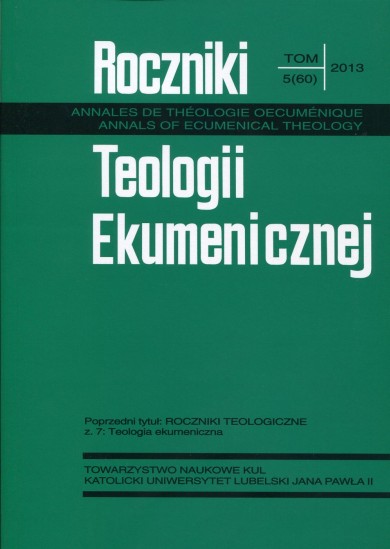Eklezjologia jedności – perspektywa rzymskokatolicka
The Ecclesiology of Unity. The Roman Catholic Perspective
Author(s): Andrzej CzajaSubject(s): Christian Theology and Religion
Published by: Katolicki Uniwersytet Lubelski Jana Pawła II - Wydział Teologii
Keywords: Roman Catholic Church; Ecclesiology; Unity; communion; fellowship
Summary/Abstract: The Author starts his investigations taking into account the “communion-unity” phenomenon. He underlines that this kind of unity of the Church implies various participations in the same common essence, namely in one God, in one Mediator Jesus Christ, in one Spirit, in one common faith, in one Baptism and in one Eucharist. The “communion-unity” of the Church is a God’s gift and the fruit of God’s initiative, fulfilled in the Paschal Mystery. There are two levels of the ecclesial “communion-unity”: the universal communion of the faithful and the communion of Christian Churches. The second part of the article describes the fraternal fellowship (communion) of the faithful. The Roman Catholic ecclesiology of unity distinguishes two kinds of membership of Christians in the universal communion of the faithful: the full belonging of all Roman Catholics and the partial belonging of non Catholics. The unity of the fellowship of Christian Churches is depicted in the third part of the article. Since the apostolic period there existed fellowships (communions) which were the local Churches. In each of them there is the whole Church, because in each of them the universal Church of Jesus Christ – one, holy, catholic and apostolic, has been manifested. The Church on the Earth has not only been the Body of many members in unity with the Head, but the Body of the Churches (corpus Ecclesiarum), the communion of the Churches (communio Ecclesiarum) as well. There exists a certain – although not perfect – implementation of the “communion-unity” between the Roman Catholic Church and the other Churches and ecclesial fellowships (communions). The care about the full unity of Christians, as the imperative of Christian conscience enlighten by faith and led by love, is stressed in the fourth part of the article. In order to restore the full communion of disciples of Christ it is necessary to restore the visible bonds, such as: faith, sacraments and supervision. The visible communion of the Church should be the reconcilled diversity, which does not contradict the unity; it should be the permanent unity in diversity. The Author in the concluding part of the article attempts to explain how to interpret the notion subsistit adopted by The Second Vatican Ecumenical Council. Describing the mystery of duration of the Catholic unity, the investigator clarifies that from the Roman Catholic point of view the conviction that the Church of Christ subsistit in her fullness in the Roman Catholic Church does not exclude the recognition of ecclesial existence and qualities of other Christian Churches and Fellowships. Above all one has to remember that the conciliar notion subsistit should be connected with an idea of the pre-existence of the Church in God’s intention.
Journal: Roczniki Teologii Ekumenicznej
- Issue Year: 2010
- Issue No: 2 (57)
- Page Range: 5-20
- Page Count: 16
- Language: Polish

